WC Gar Nash's Sinking of German Submarine UIT-22
By Dr. JC van der Walt, Richards Bay
(This article is based on a series of interviews by the author with Wing Commander ESS "Gar" Nash DFC, AFC.)
During World War Two (1939 - 1945), seventy-five Consolidated Catalina Flying Bomber Boats of ten Squadrons of the Royal Air Force, operated from anchorages in Lake St Lucia, Lake Mzingazi in Richards Bay, Congella in Durban, Bot River, Breede River and Langebaan Lagoon. The flying boats were used to spot and to destroy German U-boats. The total number of Allied ships lost to Japanese and German submarines off the South African coast was 163.
The PBY Catalina is possibly the most prolifically built amphibious aircraft ever created. Some 3 200 Catalina's' were built in the years 1939 to 1945. The Catalina's were powered by two 1 200 hp renowned Pratt & Whitney Twin Wasp R-1830 14-cylinder engines. These amazing airplanes saw service in Canada, Australia, the Pacific and Europe. The plane derived its nickname, "Catalina", from the island off California of the same name. The pilots used to practice their watery "touch-and-goes" between Catalina Island and the mainland.
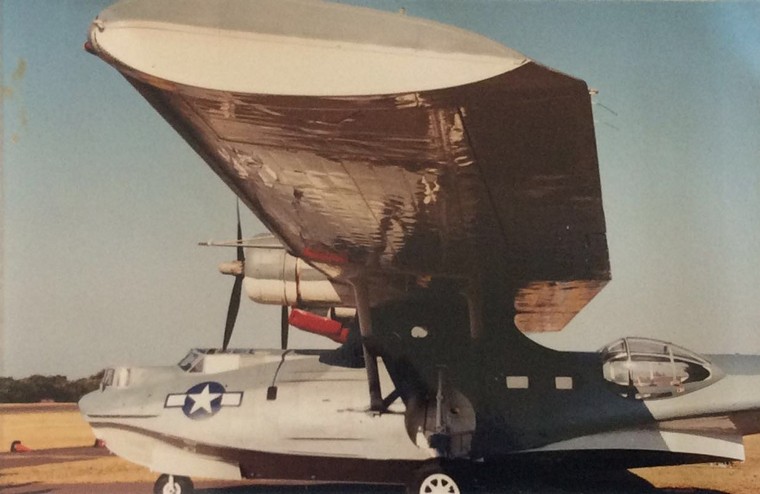
This restored and airworthy Catalina Flying Boat belonged to Graham MacPherson. Photo by Dr. JC van der Walt, Virginia Air Show, 8 July 1998
The Catalina was a big plane. It had a loaded mass of 15 400 kilograms, a wing span of 31,7 meters, length of 19,5 meters, and height of 5,65 meters. The Catalina had two machine guns in its glass "blisters", one machine gun in its bow turret and one machine gun in the tunnel underside the hull. It also carried three depth charges underneath each of its wings.
A remarkable feature of the Catalina was its long range of 4 030 kilometers. It could stay aloft for 22 hours. The maximum speed was 329 km per hour and the cruising speed was 200 km per hour. The two pilots and a crew of eight had a fully fitted kitchen with an electric stove as well as a comfortable toilet on board.
The mooring compartment was at the front turret position. The cockpit was very close to the water. The two huge propellers were directly above the pilots. Close spacing of the two engines from each other enabled the pilot to fly and land on one engine. The wings had wing floats and under wing aerials. The six depth charges were beneath the wings externally at the ends of the wing struts. The pilots had to dive down to a height of only 25 meters to accurately drop the depth charges on top of the U-boats.
Normally the pilots had only one shot at a submarine, releasing a single stick of depth charges. It took a straddle across the submarine or a single depth charge to the hull to "kill" a submarine. The U-boats were armed with 20 mm and 37 mm anti-aircraft guns firing explosive shells in addition to their 3,4 inch shell guns. The submarines outgunned the 0,303- inch and 0,5- inch bullet firing machine guns of the Catalinas.
The Catalinas were reliable. In South Africa there were no engine failures that led to loss of life. Some planes limped back to base full of shell and bullet holes fired from enemy submarines, leaking oil and using only one engine.
Wing Commander ESS "Gar" Nash, DFC, AFC, (75) in 1994.Wing Commander E.S.S. (Gar) Nash of 262 Squadron, Royal Air Force, was a South African born in Grahamstown in 1919. He joined the RAF in May 1939. Flight-Lieutenant Nash and his crew ferried Catalina, FP 174 "P", from RAF base, Pembroke Dock, South West Wales, to Langebaan. He left on 27January1944, flying south over the Bay of Biscay, to Gibraltar and then along the coast of North Africa to Libreville. Here he turned east and flew to Kisangani, to Kisimu on Lake Victoria and then under Kilimanjaro to Mombasa on the East coast. From Mombasa he flew south east to Antsiranana in northern Madagascar, then south to Toliara in southern Madagascar and then south west to Lake St Lucia in Zululand. Nash landed in Durban on 4 March 1944. He was quartered at the Clairwood race- course. He landed in Langebaan Lagoon on 6 March 1944. The total distance travelled was 20 306 kilometers. Five days later, on 11 March 1944, in the same Catalina, he sunk German U-boat UIT-22, killing all 46 hands.
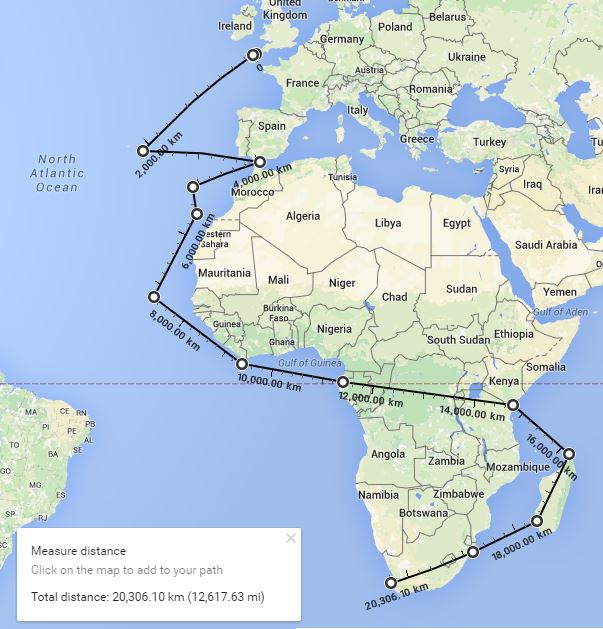
The distance travelled from Pembroke Dock to Langebaan Lagoon is 20 306 kilometers
The Wing Commander told me, "We almost missed the African continent flying south from Tulear in Madagascar. This was due to a 16-degree navigation error. We almost went south forever. The direct reading compass was influenced by soft magnetism of a boat hook stored close to the can of the DRC. The P4 compass was completely wrong at the time, and we flew south for several hours before second pilot, Peter Wills, coming back from the toilet, removed the boat hook and the DRC repeater swung back in agreement with the trustworthy P9 compass."
Gar Nash stressed that they would have used the sun to give them a fix as they would not got lost at sea easily. Nash continued, "After the delights of Durban, we were on our way to Langebaan on 6 March 1944. I was away from my parents and my brothers, James and Henry, for five years while overseas - and I circled my parents' home in the Catalina. The house was in Hamburg on the estuary of the Keiskamma River."
"Where your parents at home when you circled in your Catalina? I asked. "No, friends were at our home on holiday. On closer inspection, I recognised a friend of ours running out of the house and waving my father's hat. Another friend staying at the house had a 16mm Kodak movie camera and he filmed the low flying Catalina." "How did you recognize your father's hat?"I asked. He replied,"I was flying rather low, you know!" He also creased the surface of the Keiskamma River with the keel of his Catalina before heading towards Langebaan.
"I remember the Morse signal SSS - SSS at 10h20 (Actually 10h48) on the morning of 11 March, signaling that Ft Lt FJ Roddick in Catalina "D" was making his attack on a U-boat far below our Catalina," said Gar Nash.

The German submarine UIT-22 leaves Bordeaux for the last time
Pilots Roddick, Surridge and Nash took off from Langebaan at 04h20 on the morning of 11 March 1944 on, "Operation Wicketkeeper", and they flew south in their three identical Catalinas in search of three suspected U-boats. At 10h48 Roddick spotted the U-boat on the surface at co-ordinates, 41.28S and 17.40E, some 939 kilometers from Langebaan. He attacked twice and he dropped five 250 lb depth charges on top of the surfaced U-boat. He also fired all guns. When Nash arrived at the scene of battle, he observed evidence of debris and an oil slick where the U-boat had submerged. To his amazement, "The U-boat surfaced in front of my eyes!"
Roddick's Catalina was severely damaged by the 20mm and 37mm U-boat anti-aircraft guns firing explosive shells. The port wing and the float mechanism were damaged and the starboard engine was leaking oil.
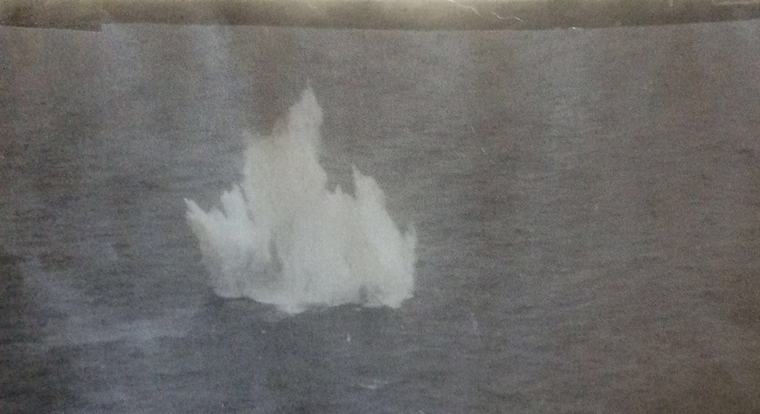
UIT-22 under attack. Pilot Officer, later Flight-Lieutenant FJ "Fred" Roddick dropped five depth charges spot on target and he crippled the submarine, forcing it to submerge. When it surfaced, Gar Nash sunk it with six depth charges
"Roddick was a bright chap. We then had the bearing and Roddick had to go back to base," said Gar Nash. He could see the conning tower of the U-boat clearly, and at 11h33 he dropped all six 250 lb depth charges from a height of only 25 meters. It was a perfect straddle. UIT-22 was sunk.
"Tommy Tromans in the bow turret opened up with his twin 0,3 inch Vickers machine gun. The depth charges exploded beneath the water's surface and the U-boat sunk under the waves forever." All 46 hands were killed.
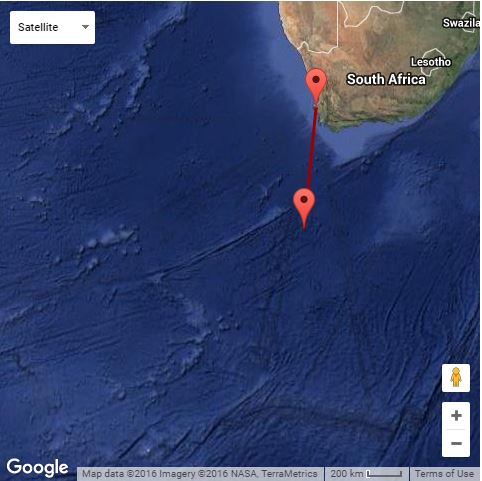
Google map illustrating that UIT-22 was sunk 939 km south of Langebaan
Gar Nash remained in the attack area for another two-and-a half- hours, making sure that he did not collide with Surridge's Catalina in the stormy weather. Nash eventually landed at Langebaan at 17h25 after spending 13 hours in the air. He was too tired to celebrate the "kill".
Nash was close to tears as he lamented, "It is certainly not easy to talk about my feelings. Suddenly you realise that your finger was on the button that killed other people. It was really upsetting. I knew we were trained to kill - it was war - they were the enemy - it was….. a job. That night my heart was filled with sadness."
A few nights later, Gar Nash sat alone on the beach whilst the whole contingent celebrated the U-boat "kill" with free beer and braaivleis. Gar was in no mood to party. It was the third (and last) U-boat "kill" in South African waters.
Oberleutnant zur See, Karel Wunderlich (32). (Two Iron Crosses and U-boat War Badge 1939). He did not sink or damage a single Allied ship. Nash said the irony is that UIT-22 (formerly the Italian submarine, "Alpino Bagnolini" of 1 166 tons), was a replenishment submarine under the command of Oberleutnant zur See, Karel Wunderlich (32). His first patrol lasted only 46 days."UIT-22 was a formidable adversary," said Gar Nash.
"Just before the "kill" we had a fire on board the Catalina", said Nash. "The crew was preparing breakfast at dawn. The Catalinas had two electric plates on board - but the things seldom worked. One of the primus stoves of the Clyde Cooker had a mishap and the methylated spirits burst into flames. The face of Ted Walker was severely burnt. This could have been very serious with 5 000 liters of petrol in the wings!" Walker was bandaged up with "yellow jelly" for his burns and Gar told him to relax. "Ted was then put on the port bunk for the rest of the sortie," chuckled Nash.
The German U-boat radio transmissions were in secret ENIGMA code. This secret code was later decoded and translated by the British in a top-secret operation called ULTRA. The radio transmissions enabled the Allied intelligence officers to calculate the positions of U-boats. The British had to protect the ULTRA secret otherwise the Germans would have used new codes.
The sinking of U-boat UIT-22 might also have been the result of brilliant intelligence work by Post Office and Eskom operators of South African-designed Radio Direction Finders, that resulted in locating and sinking of U-197 on 20 August 1943 (973 km east of St Lucia and 413 km south of Madagascar), by two Catalina Flying Boats, one from Lake St Lucia in Zululand and one from Toliara, Madagascar. All 67 hands in U-197 were killed.
Pilot Officer FJ Roddick was fearless. UIT-22 was his second attack on a U-boat. Flying 100 kilometers east from St Lucia on 12 July 1943, he dropped six 250 lb depth charges on U-197. He missed. Roddick was awarded the DFC on 29 April 1944. He was the main hero of the third U-boat "kill". Wing Commander, DB Osmonde-White, organized a party to celebrate his decoration. He was later promoted to Flight-Lieutenant. Gar Nash was promoted to Wing Commander of 262 Squadron RAF on 25 November 1944 and on 15 February 1945 he was appointed Wing Commander of the new 35 Squadron, South African Air Force.
During their many long distance anti-submarine patrols, convoy escorts, and search and rescue missions, the 75 Catalina Flying Bomber Boats saved hundreds of Allied ships and thousands of lives. They sunk U-197 and UIT-22 and damaged U-859.
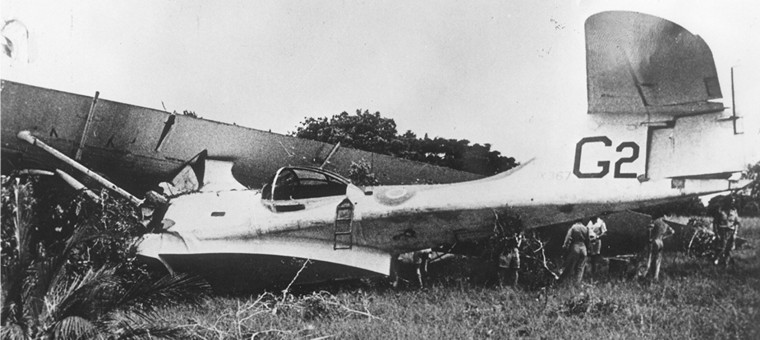
Catalina Flying Boat, JX 367 "G2", crashed at Richards Bay on 30 January 1945, killing first Pilot, Flying Officer WW Lake (RAF) and second Pilot, Captain HN Honey (SAAF)
Sadly, eighteen British-, Australian-, Canadian- and South African Catalina airmen died in fatal crashes in Zululand. The wreck of Catalina 275 "E" that crashed during a night landing in Lake St Lucia on 7 June 1942, in which eight airmen died, was discovered during a severe drought in May 2003. Unfortunately this wreck was used for bomb practice and almost nothing remains of it today. Catalina FP 265 "H" crashed in Lake St Lucia during a night departure on 25 June 1942, killing four British- and four Canadian airmen. The body of the second Pilot, a Canadian, Flight-Sergeant AF Jenkins, was never found. The wreck still lies in deep water, waiting to be salvaged. Catalina JX 367 "G2" crashed during a night landing in Lake Mzingazi, Richards Bay, on 30 January 1945, killing Flying-Officer WW Lake (RAF) and Captain HN Honey (SAAF).
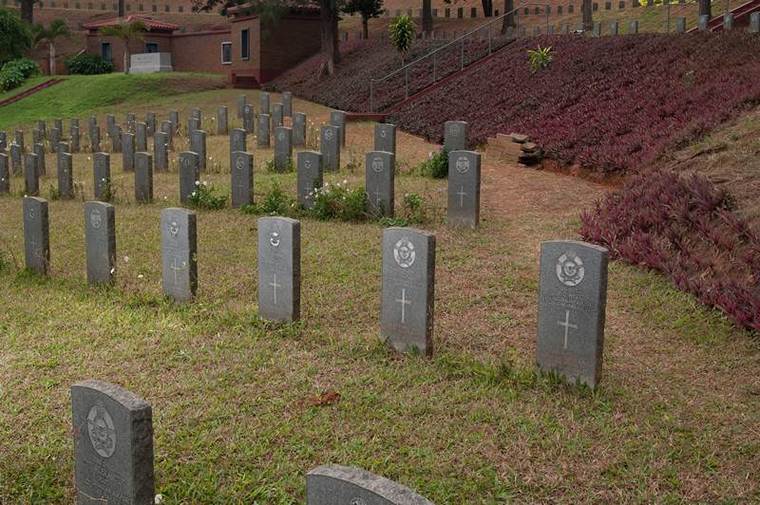
Stellawood cemetery, Durban, the final resting place and monument to commemorate the eighteen British-, Australian-, Canadian- and South African Catalina airmen who died in Zululand
All eighteen dead Catalina airmen were buried in Stellawood cemetery in Durban. The graves are very well maintained and a special monument is dedicated to these daring men.
The last vestige of the flying boat era is an intact flying boat fuel tank on the farm "Karmel", Gingindlovu, Zululand, belonging to Mr. Manfred Kramer.
Wing Commander ESS "Gar" Nash, DFC, AFC, died in Whangaparoa, New Zealand on 7 July 2002 at the age of 83 years.
SOURCES:
1). Spring Ivan, "Flying Boat", first edition, 1995.
2). van der Walt JC, "Zululand true Stories 1780-1978", fifth edition, 2011.
|
           |























